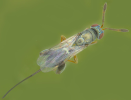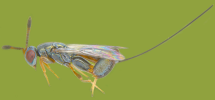 |
Scientific namePodagrion sp.
Taxonomic positionHymenoptera: Chalcidoidea: Torymidae
DiagnosisBody usually metallic green / bluish with abdomen and / or legs sometimes orange-yellow or lighter. Antenna with first flagellar segment transverse, anelliform. Propodeum often with distinct
carinae in the form of wide inverted V or Y. Hind coxa and hind femur long and conspicuous; hind femur distinctly enlarged with a series of serrations on inner margin; apical spine of hind tibia less than 2x as long as breadth of tibia. Ovipositor much longer than gaster and distinctly exserted (Boucek, 1988).
Commonly collected as parasitoids of mantid oothecae. ImagesDistribution
Tropicopolitan / all warmer regions of the world (Boucek, 1988).
Hosts / Associated habitAll known species are parasites in the oothecae of praying mantids (Mantodea) and each individual consumes one host egg during its development (Boucek, 1988). The Indian species of Podagrion have been comprehensively dealt with and keyed by Narendran.
Reference
|




